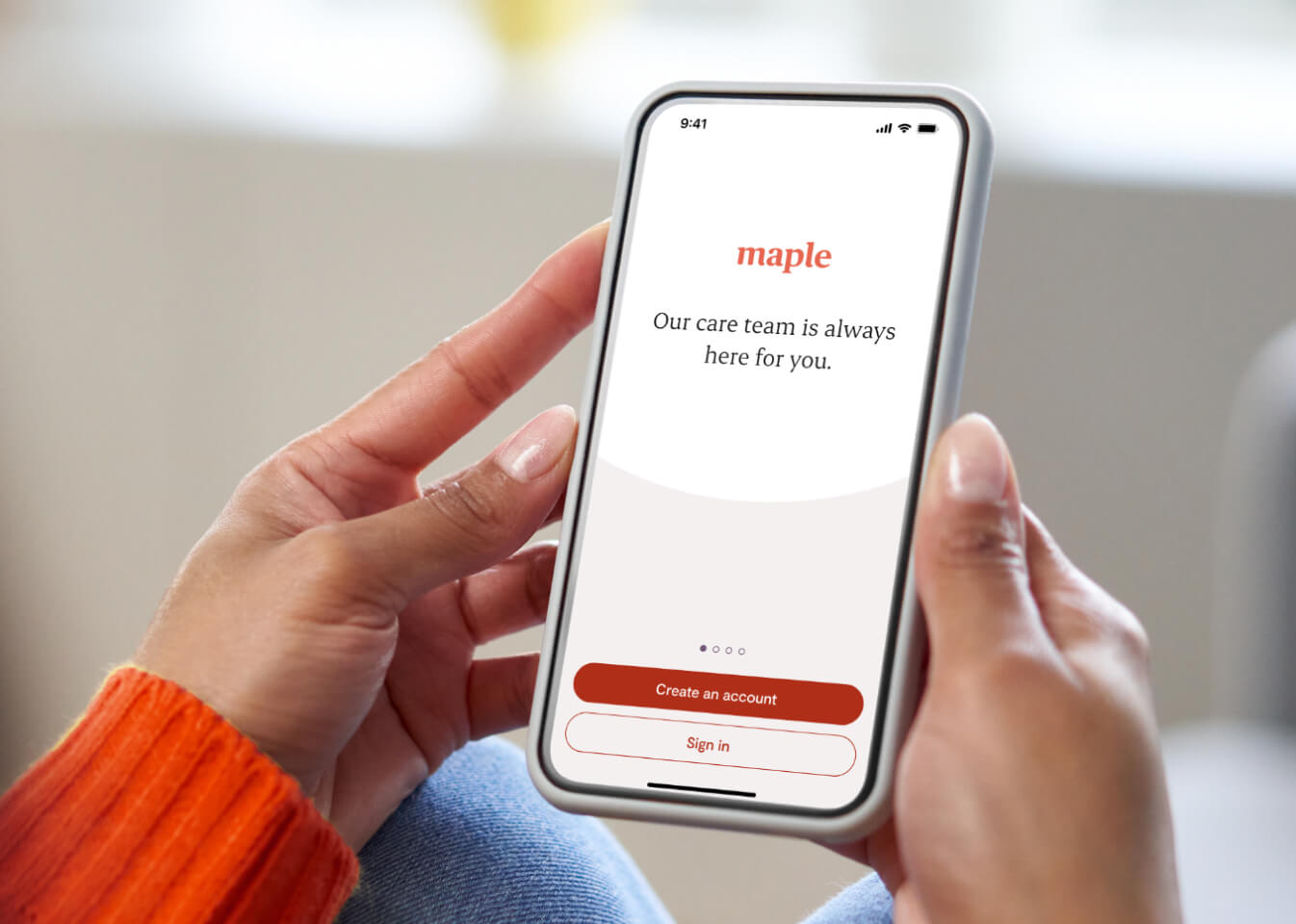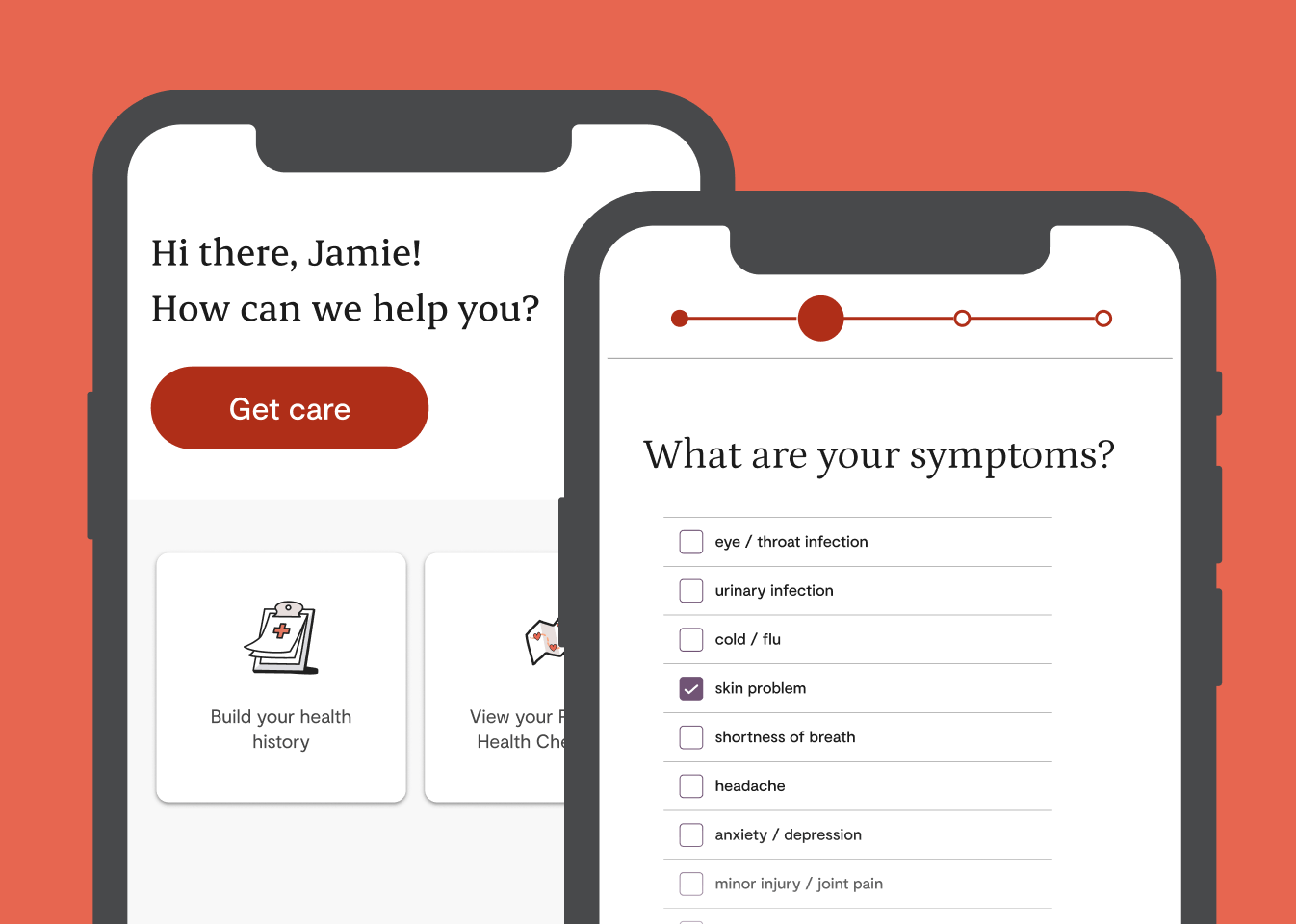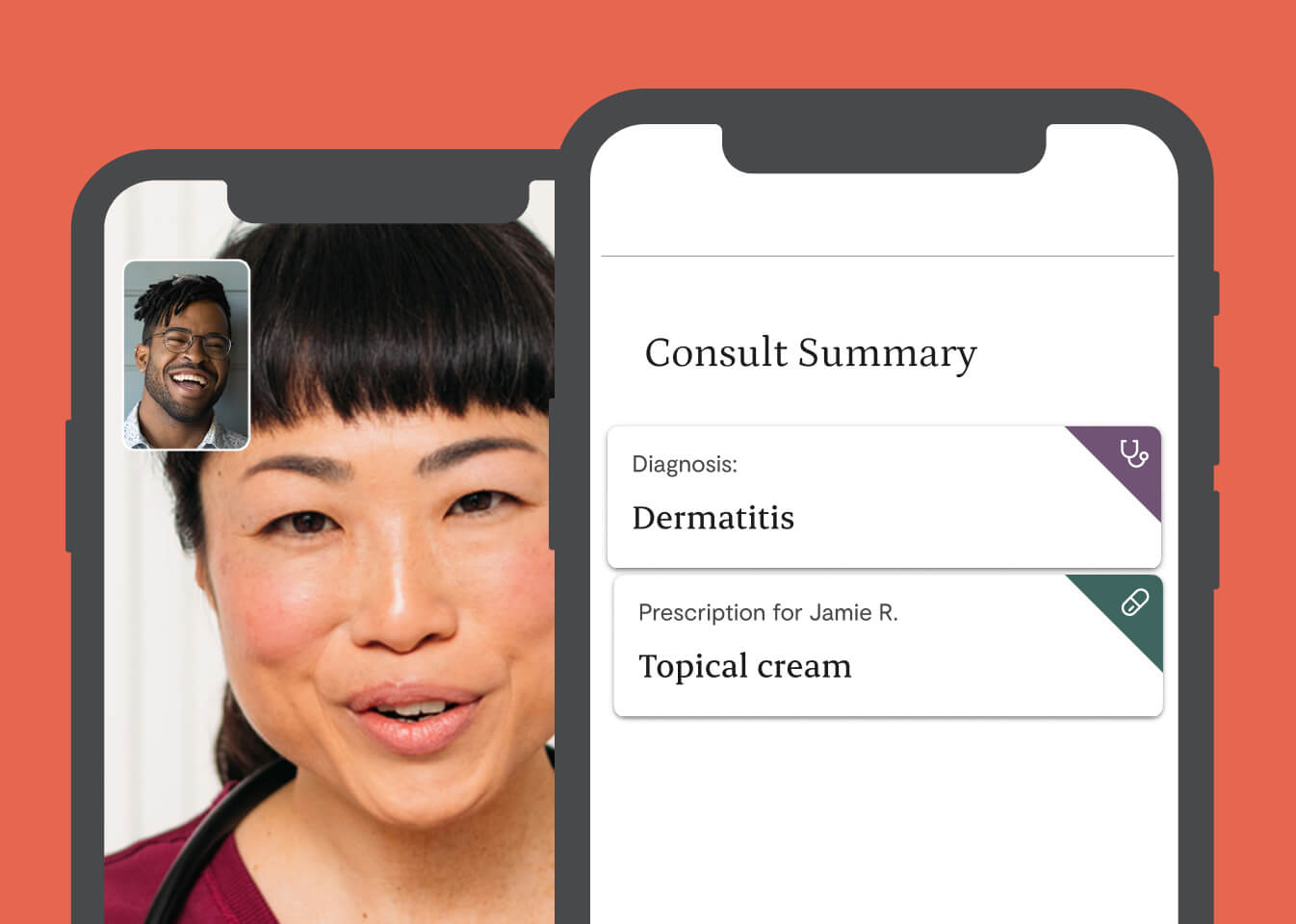Laryngitis treatment, diagnosis & prescriptions
Skip the waiting room! Instantly connect with Canadian doctors for medical care from your phone, tablet or computer - any time, 24/7.

- Prescriptions available at a provider's discretion
- Speak to a doctor or nurse practitioner
- 24/7 availability
- Get connected in minutes
Trusted by millions of Canadians
- 4.8 rating30K+ App Store reviews
- 4.7 score8K+ Trustpilot reviews
Talk to a doctor about laryngitis treatment online
See a doctor or nurse practitioner today to get a new prescription or refill, at their discretion.
See a provider in three easy steps.
- 1
Register and become a member

- 2
Select the “Get care” button on our homepage

- 3
Connect with a Canadian-licensed doctor or nurse practitioner in minutes

Why Canadians love Maple
A fantastic way to get medical advice when you are unable to see someone in person. The app is so simple to use. Highly recommend. I am not a tech savvy person but the doctor was kind enough to patiently walk me through every step of the process. Thank you.
Saved me hours waiting in the ER.
Fast and effective tool for getting a diagnosis and prescription.
The doctor willingly took the time to explain things to me.
Very easy to book a therapist and get appointment receipts.
Frequently asked questions
About Laryngitis
Yes. In most cases, a doctor from Maple will be able to offer a laryngitis diagnosis by evaluating your condition and discussing your symptoms.
If you experience chronic or recurrent laryngitis, or if your doctor believes that laryngitis could be a symptom of another underlying condition, they may request you to visit a clinic in person so a laryngoscopy can be performed. This involves using a small device or a light and a mirror to check your vocal cord area.
If the doctor believes your laryngitis could be caused by bacteria, they may also take a sample of some mucus to send to a lab for evaluation.
Yes. Physicians on Maple can prescribe medications online during your consultation. Once you accept a prescription, you’ll have the option to pick it up from any pharmacy or to have it delivered to your door at no additional cost.
For more information, visit our How it works page.
On the interior of the larynx are two folds of mucous membrane that cover muscles and cartilage. These are called the vocal cords, and the noises we make when we speak are caused by their movement and vibrations.
Normally, they open and close smoothly. However, laryngitis occurs when the larynx becomes inflamed or irritated. This changes how the air passes through the vocal cords and how they vibrate.
Depending on the severity of the condition, these changes can impact the vocal cords in different ways, ranging from hoarseness to total loss of voice.
Common laryngitis symptoms include:
- Sore or dry throat
- Dry cough
- Weak voice
- Voice loss
- Irritation or pain when trying to speak
- Hoarseness
These laryngitis symptoms are considered normal and aren’t a cause for alarm. However, you should seek medical attention if you begin to experience:
- Severe throat pain
- Difficulty or inability to swallow
- Coughing up blood
- Difficulty breathing
- Long-lasting fever
Moreover, children may experience additional symptoms that include:
- Excessive drooling
- Noisy or high-pitched sounds when inhaling
- A fever of 103 F (39.4 C) or higher
If your child begins to experience any of the more severe laryngitis symptoms, they should see a doctor immediately.
The most common laryngitis causes are:
- Inflammation
- Irritation
- Infection
There are two types of laryngitis, acute and chronic. The type of laryngitis you’re experiencing will also help your doctor determine the direct cause of your condition.
The laryngitis treatment recommended by your doctor will depend on what they determine to be the cause of your condition.
In acute cases of laryngitis, rest and self-care measures are usually recommended. The laryngitis should clear up within a week or so. Normally, no laryngitis medication is required, although over-the-counter sore throat lozenges may help alleviate some symptoms.
If the doctor believes laryngitis could be a symptom of another underlying condition or habit, such as smoking, they may make recommendations to help alleviate your laryngitis symptoms.
For children who are suffering from laryngitis due to croup, or if there is an urgent need to reduce vocal cord inflammation, the doctor may prescribe corticosteroids to help reduce swelling.
In most cases, acute laryngitis is caused by overuse or viral infections and isn’t contagious.
However, laryngitis can be contagious if it’s caused by a bacterial or fungal infection. Droplets that are discharged when an infected person coughs or sneezes can spread laryngitis.
While both laryngitis and pharyngitis are caused by inflammation, laryngitis affects the larynx (vocal cords) while pharyngitis affects the pharynx (back of the throat). They both share similar symptoms and recovery periods.
Although acute and chronic types of these conditions have very similar treatment methods, the biggest difference between them is that they affect different areas.
Laryngitis is caused by inflammation of the vocal cords, usually brought on by overuse or a viral infection. Occasionally, a bacterial infection such as group A Streptococcus – also known as strep throat – can cause this condition.
Strep throat can affect the entire upper respiratory tract while laryngitis is confined to the larynx.
Yes. In some cases, laryngitis can cause a sore throat or irritation around the vocal cords, which results in discomfort.
Most of the time, pain will be mild. However, in some serious cases, pain can become more intense. This usually occurs when your laryngitis is caused by an infection that becomes severe.
Typically, acute laryngitis has a recovery time of about a week or so. It’s important to remember to rest your vocal cords as much as possible when you’re experiencing laryngitis. Continued overuse could increase the amount of time required for them to heal.
Laryngitis caused by other underlying conditions or habits may take much longer to heal, depending on how quickly the underlying conditions can be identified and treated.
Occasionally, for very severe cases, laryngitis can cause difficulty breathing, which can lead to shortness of breath.
This can be avoided by refraining from performing physically demanding activities until your laryngitis symptoms become less severe.
Bronchitis is an inflammation of the lining of your bronchial tubes. These tubes carry air to and from your lungs.
Acute bronchitis is usually caused by a viral infection. The most common cause of chronic bronchitis is cigarette smoking. Dust and bad air quality can also contribute to the condition.
If you’re already experiencing an upper respiratory infection like bronchitis or another bacterial infection, laryngitis can be one of the symptoms you experience.
Maple 101
Maple is a virtual care platform that connects you with doctors and other healthcare providers via text, audio, or video. After you log in to your Maple account, you can request an online consultation.
Consultations work similarly to in-person appointments — the doctor can complete an assessment by asking questions about your symptoms, going through your health history, and determining what treatment is right for you. If they think your condition is more serious, they may tell you to go to a clinic for an in-person examination.
As a Maple member, you get 24/7 access to virtual primary care online and more. You can connect with our network of providers via text, audio, or video call within minutes.
Pricing and Payment
Our membership costs $85/month and covers virtual care for patients and their families, including the primary account holder's spouse and any dependents.
For patients in eligible provinces, our membership includes:
- Access to daily primary care provider visits: One daily visit with a primary care provider for each family member in their household.
- Paediatric care: Covered paediatric primary care visits, available by appointment.
- Second medical opinions: access to a network of experts for a second opinion if diagnosed with a complex condition (e.g. cancer).
- Personal Health Check-Ins: A series of personalized, evidence-based proactive care screenings to maintain and improve health.
- iCBT courses: Access to iCBT (internet-based cognitive behavioural therapy) self-assessment and courses.
- Access to specialists in eligible provinces: Easy access to specialists on Maple within days, not months. No referral is needed.
- Specialist referrals in eligible provinces: Ability to be referred to a physician specialist for in-person care, if needed.
- Credit discounts: An $80 credit per month to be applied to a Maple specialist visit.
Please note that our membership cannot be combined with other offerings, such as private insurance coverage and provincial programs, where available. In some cases, membership fees can be covered by a Healthcare Spending Account (HSA) — check with your HSA provider for more details.
We accept all major credit cards, including AMEX cards, as well as Google and Apple Pay.
Security and Privacy
At Maple, we proudly prioritize privacy as a cornerstone of our virtual care services. We strictly adhere to privacy and healthcare legislation in Canada, such as PIPEDA and PHIPA regulations, to ensure patients' personal and health information remains completely private and safeguarded.
Our policies and consent processes are designed to be simple and easily understood, empowering individuals with control and a clear understanding of their healthcare journey. When using our services, a patient’s session is protected by a comprehensive security infrastructure and stringent data policies.
Patients also retain full control of their personal health information, medical records and test results at all times. Our approach is reinforced by consultations with leading experts, guaranteeing comprehensive policy frameworks that are reviewed at a regular cadence.
All providers delivering healthcare through Maple are licensed in Canada and governed by their licensing regulatory colleges, and in all instances, must act in accordance with the governing principles set out in the telemedicine policies of each medical regulator in the applicable province.
Regulators across Canada support and recognize the value of services like ours, and the way in which they can benefit patients, physicians, and Canada’s broader healthcare system by improving access to care and increasing efficiencies in the delivery of care.
Do you need medical care today?
Trusted, experienced doctors and nurse practitioners are ready to see you.
Maple is safe and effective for common non-emergency issues. If you believe you are experiencing an emergency, please call 911 or proceed to your nearest emergency room.










